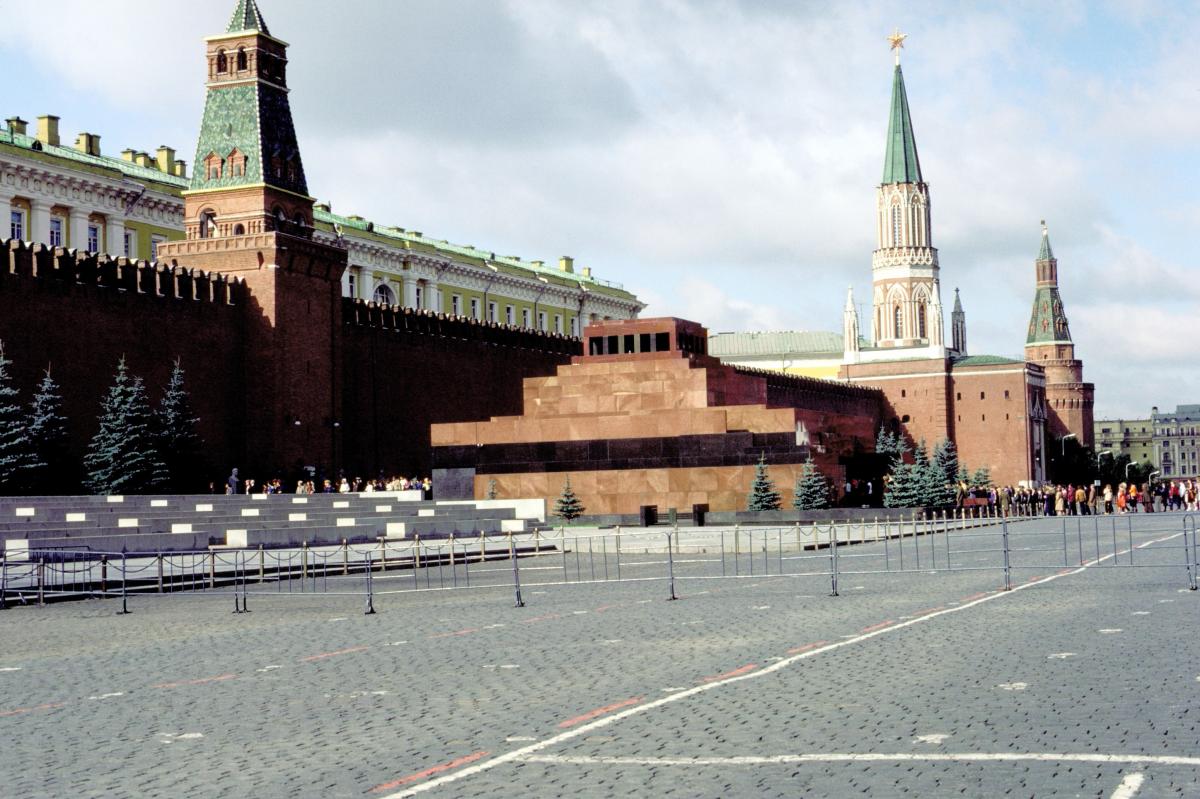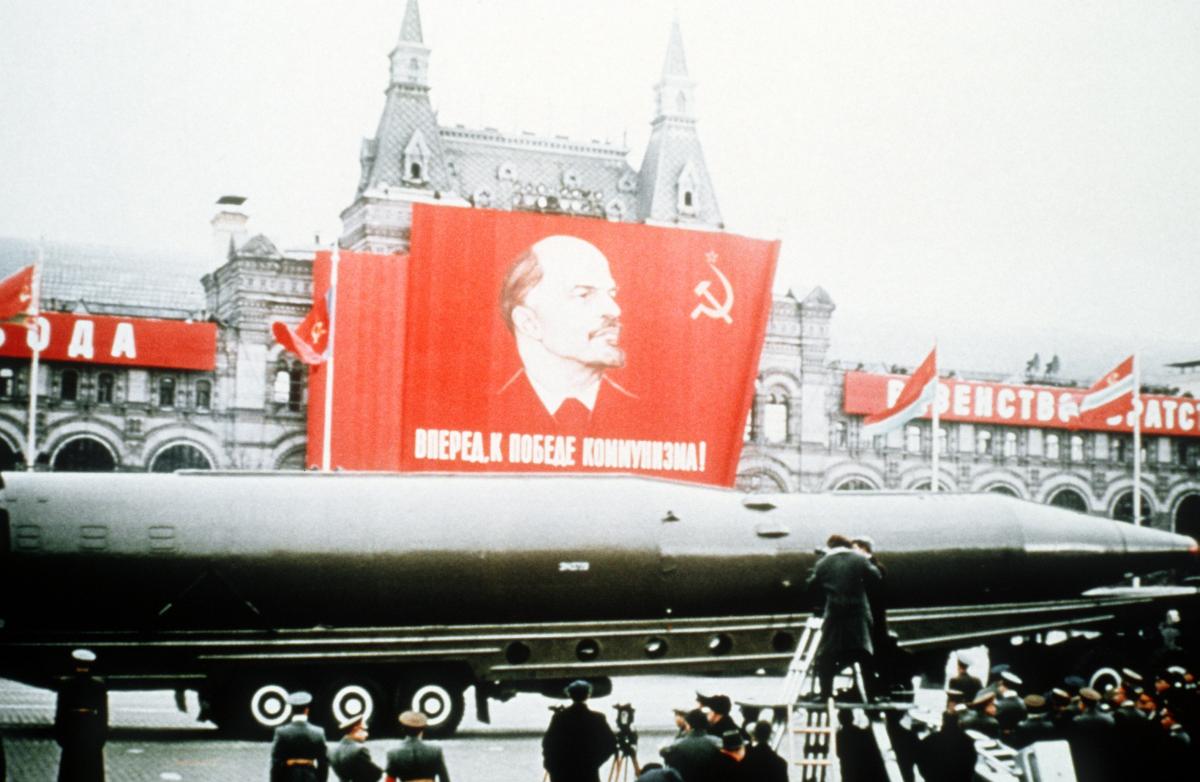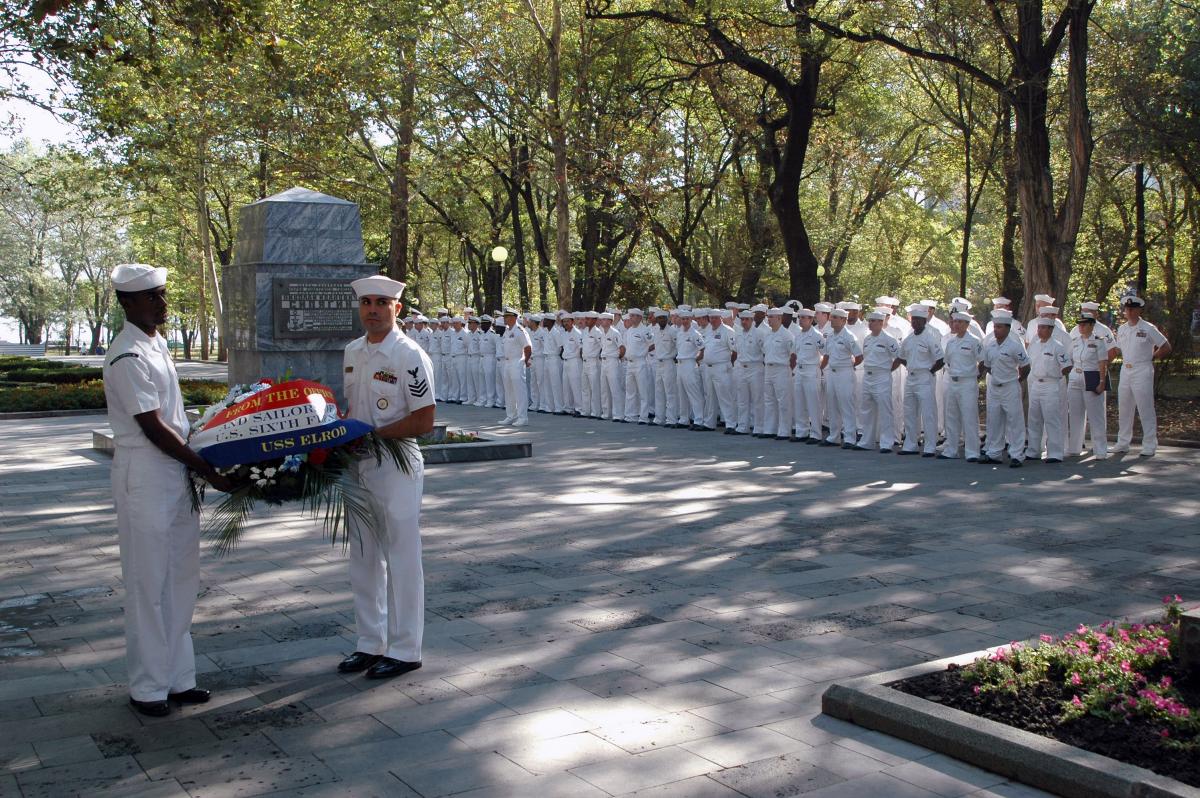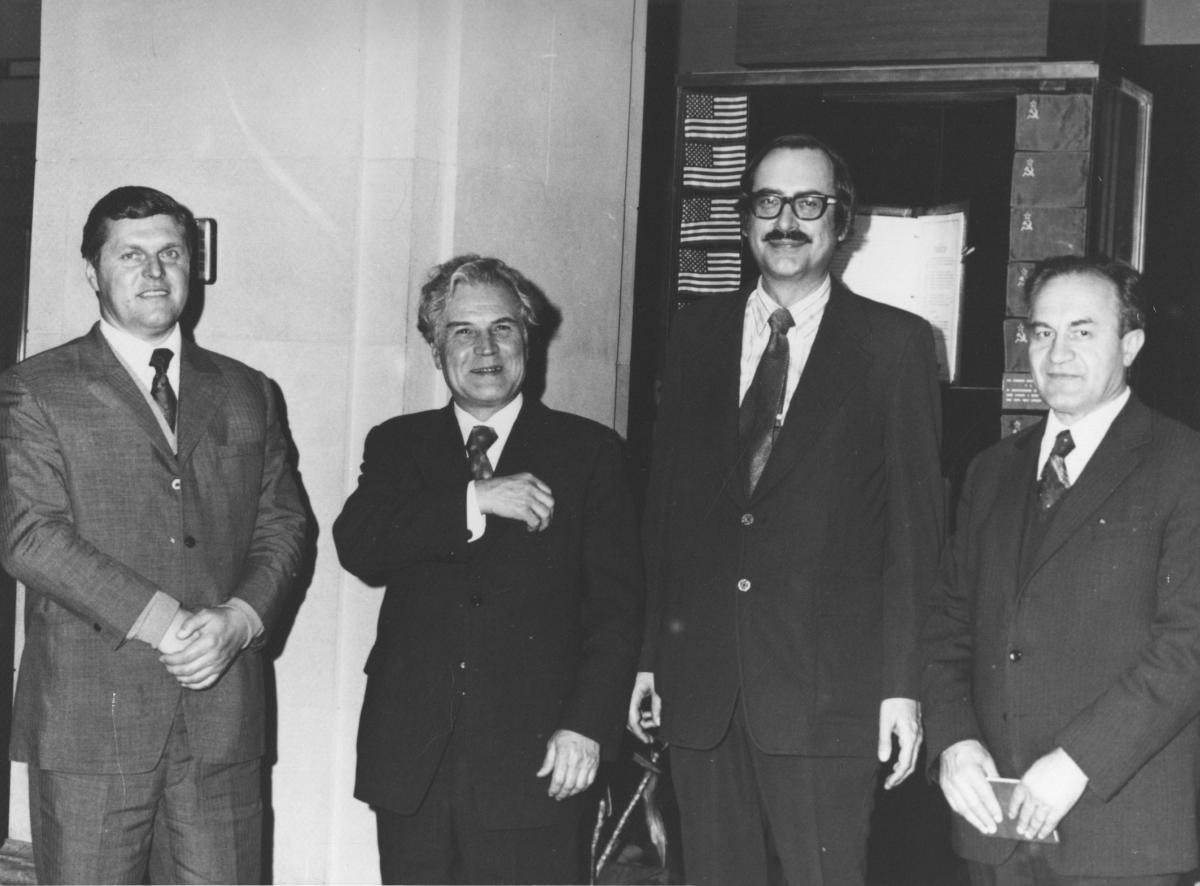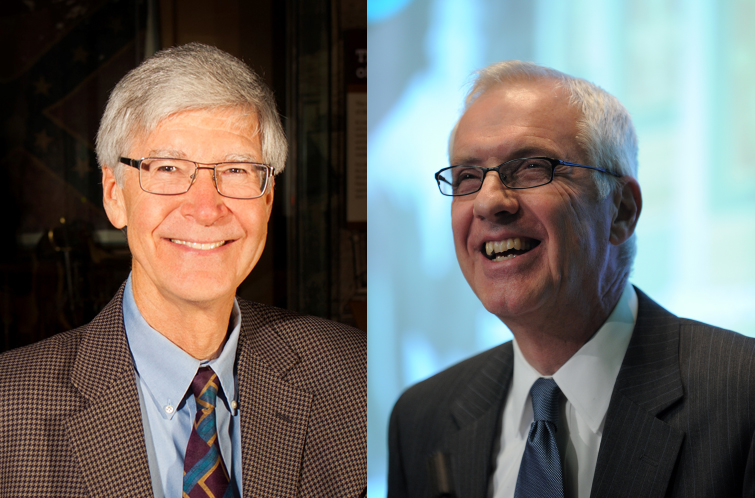
Reflections of Two American Archivists on the Soviet Union’s Archives
By Erik Moshe
Just months after President Ronald Reagan’s "Mr. Gorbachev, tear down this wall!" speech in West Berlin in 1987, two men arrived in Russia. Their destination: the Soviet Archival Research Center. They had been selected to be the first archivists from the United States to visit the archives of the Soviet Union under the U.S./USSR program of cultural exchanges. Their trip lasted from September 18 to October 2, 1987.
This visit was one of a series of exchanges authorized by agreements between the Commission on Soviet-American Archival Cooperation of the American Council of Learned Societies and the Main Archival Administration of the USSR Council of Ministers, administered in the U.S. by the International Research and Exchanges Board (IREX).
Edwin C. Bridges, director of the Alabama Department of Archives and History, and Francis X. Blouin, Jr., director of the Bentley Historical Library at the University of Michigan, had different professional agendas for their trip: Blouin focused on archival education, while Bridges concentrated on VNIIDAD (Vsesoiuznyi nauchnoissledovatel'skii institut dokumentovedeniia i arkhivnogo dela), the primary research center for the Main Archival Administration of the USSR Council of Ministers.
The purpose of their visit was to hold open discussions with Soviet archivists and learn from each other.
During a 2017 telephone and email interview, Bridges and Blouin shared memories of their experience as visiting archivists during a tumultuous period of history.
“It was my first trip to Moscow, though not to then called Leningrad,” recalled Blouin. “I do remember standing in the Red Square looking at the red stars on the towers of Kremlin, thinking to myself: Here I am in the center of this awesome power; it was a Cold War experience.”
“We were there at the dawn of glasnost,” said Bridges. “It had been going on for maybe a year, but people were just beginning to relax a little—at least some, a few, on the cutting edge.”
The term “glasnost” means “openness” and was the name for the political and social reforms in Soviet society. Glasnost encouraged greater freedom of expression and including more people in the political process.
What was it like in Russia at that time?
“There was an English-speaking newspaper,” said Bridges, “‘Moscow News,’ that was beginning to publish occasional stories critical of Joseph Stalin. Never Vladimir Lenin, but Stalin—they talked about Stalin as a departure from Lenin. Lenin was still venerated, but they wrote about how Stalin somehow took the base that Lenin had created and twisted it and turned it toward a destructive course. At part of the center of this was this Archives/History Institute, led by a rising political star named Yuri N. Afanasyev, who became a senator in the Russian Senate. He was closely allied to Mikhail Gorbachev and to the policy of glasnost, and he had been one of the most adventurous and daring pioneers of glasnost. He held afternoon lectures and seminars each Wednesday at the Institute, where they would talk about many topics that before were not openly discussed. It appeared, in some ways, that the archivists were pioneers in glasnost.”
Both Bridges and Blouin were particularly struck with their hosts’ need to impress their guests. They toured historic churches in Red Square and the Kremlin and saw the famed “Armory” museum with its treasures of the tsars. “All of it was nothing short of extraordinary,” reminisced Blouin, “then our host would ask, ‘Did you like it?’”
He remembered laying a wreath at the mass grave of victims from the World War II siege of Leningrad: a standard ritual for all visitors to the city. “I recall that there were 500,000 dead on that site. Then they would ask if we thought it meaningful to see; their need for validation was fascinating to me.”
The idea of secular rituals was also fascinating to Blouin, like the laying of the wreath. In Moscow, they were taken to a pageant divided in three sections. First was a historical section that showed films of the decadence of life in tsarist Russia and the rise of the Bolshevik challenge culminating in revolution and the formation of the USSR. The second was a “fabulous” demonstration of the cultures of the varied ethnic groups that made up the USSR, including “spectacular” dance performances in a variety of costumes. The third was a gathering on stage of representatives of each of the ethnic groups, in costume, carrying loaves of bread. After singing songs that celebrated the unity of this diverse group and the common bond they shared under the USSR, the women took the loaves out into the theater audience and distributed pieces of bread to each in attendance.
“It was like a communion,” said Blouin, who, upon glancing at his old travel notes, observed that it had been 30 years ago on the day of the interview that he had witnessed those traditional ceremonies. “At one level, of course, that could be seen as a kind of secular state propaganda—but at another level the whole experience spoke to something deeper in Russian culture and the importance of Christian orthodoxy to it.”
What were their archival practices like?
As for archival practices, Blouin was particularly struck by their visit to the Archives of Literature and Art on the outskirts of Moscow. It was overseen by a Mrs. Volkova “who was apparently legendary in archival circles.” Her husband has been an important figure in the performing arts in the USSR. Blouin was “amazed” at the holdings of the archives, which included collections from composer Dmitri Shostakovich and film director Sergei Eisenstein.
What impressed Blouin most as he thought back on the trip was the respect the Soviets had for Russian history. Although the tsar had been slain in the revolution, he said, there was a deep respect for the history of the Russian people, a kind of nationalist thread that tied together not only various periods of Russian history but also the history of the varied cultures that formed the USSR.
“The archives were comparatively well funded in those days,” he said. “I do remember arriving at one of our meetings where the table was set for coffee in the blue and gold Russian Imperial china; it was both gracious and splendid. That would be in contrast with the early days of post Soviet Russia where the archives were less well funded.”
Taking a tour through the cultural archives with some of the records of famous Russian authors and other older records, Bridges had the feeling that Russian archivists had a kind of stock group of rare things that they would pull out to show visitors to impress them.
“I remember there was a letter Peter the Great had written back to his wife after his victory over Charles XII of Sweden at Poltava. That was one of the great turning points in Russian history. For us, it would be comparable to seeing a letter from George Washington to Martha saying, ‘we’ve beaten the British at Yorktown, they surrendered!’ It’s a letter of that level of importance. And we were wowed by it. My sense was, however, that the letter was one of those standard items they pulled out when a group of dignitaries came in and the staff wanted to show them something cool.”
Sometimes, Bridges explained, they would walk into the stacks and see records. “In tsarist Russia, there was a real clerical, bureaucratic mentality. The records that survived the communist revolution had been carefully created and beautifully kept. We could see storage areas with those kinds of records. But nothing after the Russian revolution appeared to be open for public access. Certainly, they never showed us any of those records except for cultural documents.”
“It wasn’t that they were aggressively defensive—they were warm and welcoming at a personal level—it’s just that their entire institutional set-up, their practices, their habits, and their history, were such that they didn’t let anybody like us close to any of the records of the Soviet Union in the communist era. I later met a famous historian, Dmitri Volkogonov, who was an ally of Boris Yeltsin. Volkogonov wrote a biography of Lenin, and he talked about his access to secret papers not previously available. For us as visitors, we really never even got close to those more serious records. For modern Russia, we were always kept in the cultural zone, which was non-threatening.”
What were the cultural differences they observed?
“We saw very interesting materials, but my background, training, and orientation was toward public archives and the documentation of the essential functions of government,” Bridges explained.
“I was very conscious of how their systems were designed not to open records and allow access, but to keep them for the limited few in power who might have need or desire to see them. Where our archival systems are designed with a presumption of openness and the intent of making information as widely available as possible, their systems were precisely the opposite. So our visit and our exchanges were like two different worlds talking to each other, with neither of us fully appreciating the deep heritage of the differences between us.
“I don’t think they even conceived of the kind of assumption of records as a mechanism of public accountability that we have in America. Archivists here try to make every public officials records available as soon as possible. Their orientation was towards squirreling away, guarding, controlling, and providing exclusive, limited access to a rare few.
“For the entire two weeks, it was like that duet from Leonard Bernstein’s Candide, where Candide and Cunégonde sing about ‘Oh, happy pair! Oh, happy we! It's very rare. How we agree.’ She sings about buying a yacht and living aboard it, and about enjoying a luxurious life in Paris and Rome. He sings about having a small farm, taking care of their babies, growing their own food, and tending their faithful dogs.
“They each describe the completely opposite things they long for and then they sing about how much they have in common. That was very much the situation. We had our world, they had their world, and we all agreed that ‘we are archivists working together.’ It was clear again how vast the differences are in each country’s perception of the other, and each country’s value systems and priorities.
“At that time, the Russians were beginning to be interested in American pop culture icons such as Michael Jackson. Brand-name franchises like Pepsi Cola, McDonalds, etc., were things that really interested the Russians, but those things for them were totally another world, and we as Americans had no idea how very different their world was from ours.
“It was useful to understand that when people of goodwill—which our hosts certainly seemed to be—are acting out of a value system so different from ours, it really behooves us to try to understand what their value system is. And I think it was important to try to help them understand what our value system is as well. I think the cooperation exchanges are really, really important. But for me, this trip helped me see more clearly how much we were living in vastly different worlds!” reflected Bridges.
“In our visits to Soviet archives, our hosts on several occasions noted increased efforts to make their holdings more accessible, especially through publications and exhibits. We also sensed in our discussions a willingness to consider more seriously research inquiries which would not have been accepted in the past. The conduct of the exchanges under the Soviet-American Commission on Archival Cooperation provides another example of greater openness to new ideas and new viewpoints in the Soviet archival establishment,” Bridges wrote in an article for The American Archivist shortly after his return.
Did they feel any pressure as Americans in the USSR?
When I asked Bridges if he or Blouin had felt a burden while they were visiting as representatives of the United States, he insisted that they “definitely were representatives,” not just the American archival community, but also the American community of historians.
“We were interested in trying at the same time to communicate to them something of the way we operate, but with such vastly different backgrounds and systems, I’m not even sure they understood the full implication of what our words meant. The color, the emotion, all the associative values of words we use everyday here do not always come across with just the literal meaning of the words, and so I’m not sure how much they picked up from us.
“The other part of the exchange was that they would be sending delegations to the U.S., so their delegates who came here had much more of a chance to see how we work and how we operate. Our job visiting them was to learn how they do things, to learn a little more about their world, and to try to be decent guests,” said Bridges.
“As always, when you travel, particularly professionally,” said Blouin, “you meet people and they are nice. They have the same issues and concerns—preservation, organization, building maintenance, dealing with bureaucracy, etc. There is a bonding and in that process the larger political concerns seem so remote and in some cases intrusive in what otherwise would be a cordial experience.”
“Though our schedule was obviously limited, sufficient time was always provided to pursue a line of questions,” wrote Blouin in his 1988 article. “Each visit and discussion, however, raised still more questions. As I said frequently toward the end of the visit, we came with one hundred questions and left with one thousand. The Soviets were eager to inform us, and we had much to learn. We asked most of the questions, and when we did receive questions from our Soviet colleagues, they centered on the issue of computers and information technology.”
In their visits to the Soviet archives, their hosts on several occasions noted increased efforts to make their holdings more accessible to the public, especially through exhibits. They also sensed in their discussions a willingness to take into consideration research inquiries that would have been ignored in the past. The overall exchange produced greater openness to new ideas and new viewpoints in the Soviet archives.
Three decades later, where are the two men today?
Today, Bridges is retired from the Alabama Department of History, where he served as director for more than 30 years. He recently completed a history of Alabama and is currently acting as interim executive director at the Montgomery Museum of Fine Arts while the Museum Board is conducting a director search.
Blouin is a professor in the School of Information and the Department of History at the University of Michigan, and director of the Bentley Historical Library. While their trip to the USSR was among the last of that kind of exchange before the end of the Soviet Union, in subsequent years, the Bentley Library mounted exchanges with the Russian State University for the Humanities, which housed Moscow’s old institute for archival practices (a place they did not visit or even hear about in 1987).
The Bentley Library also held a series of joint meetings with the European University in St. Petersburg. In both cases, there were meetings in Russia and in Ann Arbor, Michigan.
“Because many of their problems are similar to those confronting U.S. archivists, we can learn from the Soviets the benefits of a research center as a mechanism for addressing archival concerns at the national level,” Bridges concluded in his 1988 article.
“Greater cooperation between the archival communities of the United States and the Soviet Union can also lead to improved information sharing about both archival procedures and archival holdings. Such cooperation can not only help strengthen the archival programs of each nation, it can also provide new opportunities for both nations to see more clearly the commonality of our interests and to narrow the range of our differences.”
Perhaps this tale of two American archivists who visited the USSR isn’t merely a trivial story confined to the readership of archival audiences. The insight lent by their memories and their 1988 articles in The American Archivist help us consider our shared interests and the narrow the range of our differences.
“Oh, happy pair!
Oh, happy we!
It's very rare,
How we agree.”
—Candide
Read the two articles Bridges and Blouin wrote upon their return to the United States:
Edwin C. Bridges, “The Soviet Union's Archival Research Center: Observations of an American Visitor,” The American Archivist (Fall 1988)
Francis X. Blouin, Jr., “Moscow State Historico-Archival Institute and Archival Education in the USSR,” The American Archivist (Fall 1988)
For further reading about Soviet Archives and U.S.-Soviet relations:
The Wilson Center’s Digital Archive contains documents on the often adversarial relationship between the United States and the Soviet Union during the Cold War. The majority of the documents are reports, telegrams, and memorandums that come from Russian archives.
George Bolotenko, “Frost on the Walls in Winter: Russian and Ukrainian Archives since the Great Dislocation (1991–1999),” The American Archivist (Fall/Winter 1993).
Patricia Kennedy Grimsted, “The Russian Archives Seven Years After: ‘Purveyors of Sensations’ or ‘Shadows Cast to the Past’?” Cold War International History Project, Working Paper No. 20, Part I (September 1998), Woodrow Wilson International Center for Scholars.
Janet Bishop and Kenneth Rock, “A Long Way from Moscow”: A Collaborative Project between Archivists, Librarians, and Historians from the Steppes of Saratov Province and the High Plains of Colorado, Collaborative Librarianship, Vol. 2, issue 3 (2010).
